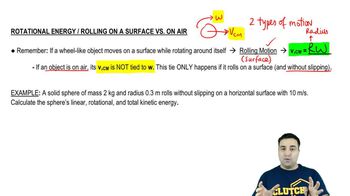Energy of Rolling Motion definitions Flashcards
 Back
BackEnergy of Rolling Motion definitions
1/15
Terms in this set (15)
- Rolling MotionA type of motion where an object moves on a surface while rotating around its own axis.
- Linear VelocityThe speed at which the center of mass of a rolling object moves along a surface.
- Angular VelocityThe rate of rotation of an object around its own axis, denoted as omega.
- Moment of InertiaA measure of an object's resistance to changes in its rotational motion, dependent on mass and shape.
- Linear Kinetic EnergyThe energy due to the motion of an object's center of mass, calculated as (1/2) * m * V^2.
- Rotational Kinetic EnergyThe energy due to an object's rotation, calculated as (1/2) * I * omega^2.
- Total Kinetic EnergyThe sum of linear and rotational kinetic energies of a rolling object.
- RadiusThe distance from the center to the edge of a circular object, crucial in calculating rolling motion.
- Solid SphereA three-dimensional object with all points on its surface equidistant from its center, used in inertia calculations.
- SurfaceThe flat or curved boundary on which an object rolls, affecting its motion characteristics.
- Without SlippingA condition where the rolling object maintains contact with the surface without sliding.
- MassThe quantity of matter in an object, influencing its inertia and kinetic energy.
- Velocity of Center of MassThe linear velocity at which the center of mass of a rolling object moves.
- Equation V_CM = R * omegaA formula linking linear and angular velocities for objects rolling without slipping.
- Horizontal SurfaceA flat plane on which an object rolls, allowing the application of rolling motion equations.


